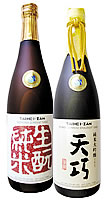Before doing so, I have to note that when I began this process, never did I dream that one day I would be a blogger and keep tab of what happened. Well, few of my good friends, including Tim Sullivan of Urban Saké Blog, suggested I start a blog.
After thinking to myself, "well, I'm not that computer illiterate, I know some html from participating in online BBs, and I'm pretty good with camera..." over the course of few month, the light did finally go on, and here we are.
I say this now, because back then, I did not religiously carry a camera to capture the essence of all the events. Therefore, bare with me on some of the older recaps when I am forced to entertain you with words and photos I "borrowed" (I swear I'll return them to where I found them!) instead of my original pictures...
March 27, 2006
Kazu and Mariko Yamazaki of Japan Prestige Saké Association invited me to a Taiheizan saké dinner at Matsuri Restaurant in Chelsea. This was memorable as the dinner featured not only sakés from Taiheizan, but they were served in the presence of Mr. Shin-ichiro Kodama, the President of the brewery.
First, a very brief introduction of the brewery: Taiheizan is named after the tallest mountains in their home prefecture of Akita. The kura was established in 1879. Their belief is to make their sakés through labor- intensive "kimoto" method, where fermentation is aided and accelerated by people physically mixing the mash using long oars. The resulting saké tend to be intense in aroma and flavor, and rich in umami.
 Now the notes about the sakés. Data, depending on availability, includes SMV, acidity, rice type, polishing ratio (seimaibuai), and yeast.
Now the notes about the sakés. Data, depending on availability, includes SMV, acidity, rice type, polishing ratio (seimaibuai), and yeast.The apertif was the sparkling and lightly nigori styled Harushika Tokimeki (SMV: -80, Acidity: 5.5, Rice: Nihonbare, Seimaibuai: 55%, Yeast: data N/A) from Nara. This is a light sparkler that I often compared to Moscato d'Asti, only more intense in flavor. Low in alcohol (7~8%), it is a refreshing and balanced saké owing to its acidity.
The main feature was of course sakés from Taiheizan. The Kimoto Junmai (SMV: +1, Acidity: 1.7, Rice: Miyamanishiki, Seimaibuai: 59%, Yeast: #1701) starts with aromas of rice, dried fruit, and grain. Full in body, the flavor is creamy with blend of nuts, cocoa, grain, and steamed rice. Finally, umami leads to a balanced finish. It paired wonderfully with the miso-marinated beef.
The biggest anticipation was the debut of Tenko, their Kimoto Junmai Daiginjo (SMV: +2, Acidity: 1.5, Rice: Yamadanishiki, Seimaibuai: 40%, Yeast: Assoc. #9). Yamadanishiki rice really comes alive in this saké, starting with a decidedly fruity on the nose, followed by a flavors of mild pear, melon, and pineapple complemented by bracing notes of grain that leads to a clean and dry finish. Although most of the daiginjo-class sakés I've had were very fruity and expressive, I do like this style of fruit/grain harmony with a clean dry finish. This is a winner, for sure.
The bonus was the first ever appearance in the United States for "A Zen Ai" Koshu (data N/A) by Wakatakya Brewery of Fukuoka Prefecture in the northern end of Kyushu Island. Evidently, this sherry-like aged saké was created in conjunction with Mr. Mikio Shinagawa, partner of the restaurant. A Zen Ai is made from Genmai, or brown rice, using the style from Genroku Era (1688-1704). It has been aged for 5 years, and has that very oxidized nutty and sherry-like aroma. The flavor starts with raisin before notes of dark chocolate and dried fruit kicks in, and the finish is mildly long.
All in all, a delightful evening, as fantastic décor, saké- friendly rustic style menu prepared by Chef Ono, and good company including the President of a saké brewery, is a winning formula for a Great Saké Experience.

No comments:
Post a Comment